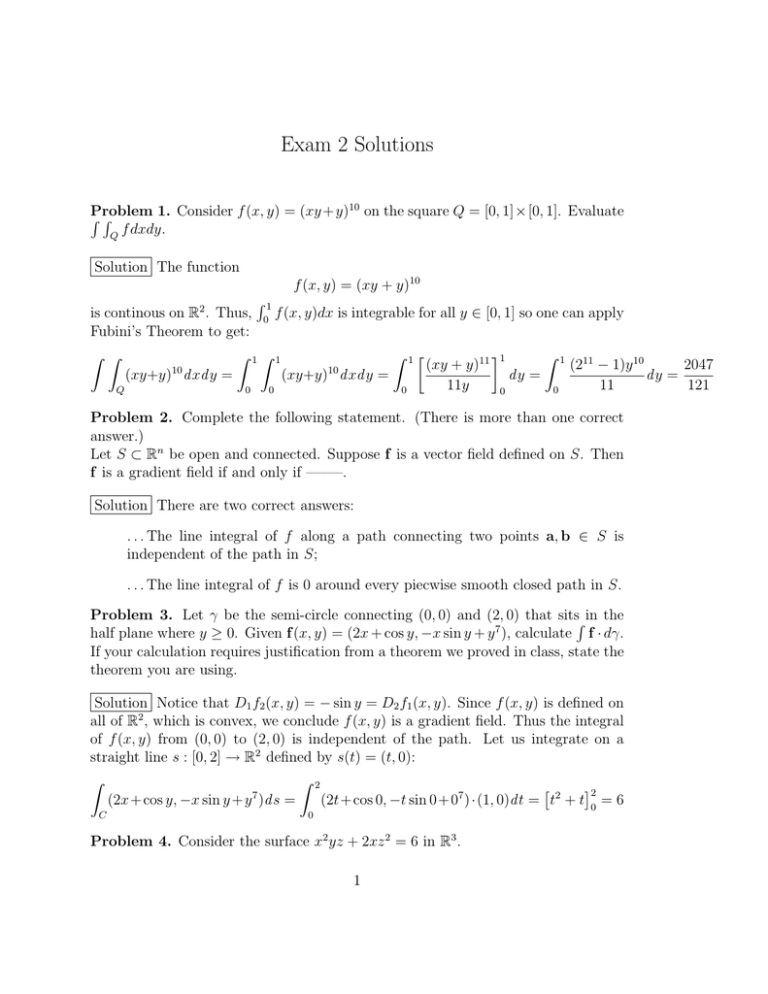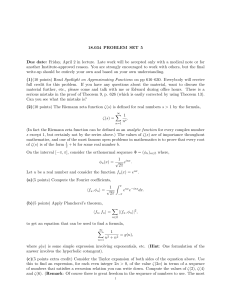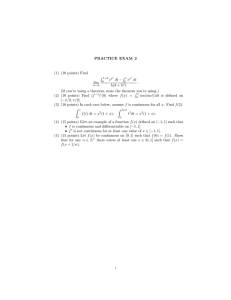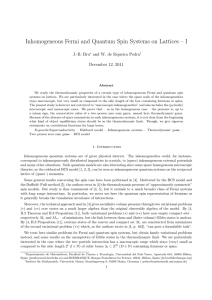Document 13562592
advertisement

Exam 2 Solutions
Problem
1. Consider f (x, y) = (xy +y)10 on the square Q = [0, 1]×[0, 1]. Evaluate
��
f dxdy.
Q
Solution The function
is continous on R2 . Thus,
Fubini’s Theorem to get:
� �
Q
10
(xy +y ) d xd y =
�
0
�1
1
f (x, y) = (xy + y)10
0
f (x, y)dx is integrable for all y ∈ [0, 1] so one can apply
�
1
0
�
10
(xy+y) d xd y =
0
1
�
(xy + y)11
11y
�1
�
dy =
0
0
1
(211 − 1)y 10
2047
dy =
11
121
Problem 2. Complete the following statement. (There is more than one correct
answer.)
Let S ⊂ Rn be open and connected. Suppose f is a vector field defined on S. Then
f is a gradient field if and only if ——–.
Solution There are two correct answers:
. . . The line integral of f along a path connecting two points a, b ∈ S is
independent of the path in S;
. . . The line integral of f is 0 around every piecwise smooth closed path in S.
Problem 3. Let γ be the semi-circle connecting (0, 0) and (2, 0) that sits� in the
half plane where y ≥ 0. Given f (x, y) = (2x + cos y, −x sin y + y 7 ), calculate f · dγ.
If your calculation requires justification from a theorem we proved in class, state the
theorem you are using.
Solution Notice that D1 f2 (x, y) = − sin y = D2 f1 (x, y). Since f (x, y) is defined on
all of R2 , which is convex, we conclude f (x, y) is a gradient field. Thus the integral
of f (x, y) from (0, 0) to (2, 0) is independent of the path. Let us integrate on a
straight line s : [0, 2] → R2 defined by s(t) = (t, 0):
�
� 2
�
�2
7
(2x+cos y, −x sin y +y )d s =
(2t+cos 0, −t sin 0+07 )· (1, 0)d t = t2 + t 0 = 6
C
0
Problem 4. Consider the surface x2 yz + 2xz 2 = 6 in R3 .
1
1. For (x, y) = (1, 4), determine all values of z such that (1, 4, z) is on the surface.
2. For each of the values of z found above, determine at which of the points
(1, 4, z) one can apply the implicit function theorem.
3. Choose one point from part (b) where the implicit function theorem can be
applied and let g(x, y) = z be the function defined in a neighborhood of (1, 4)
such that (x, y, g(x, y)) is on the surface. Find ∇g(1, 4).
Solution
1. By substitution we get 4z + 2z 2 = 6 or z 2 + 2z − 3 = 0. This easily factors into
(z − 1)(z + 3) = 0 and the zero product property implies z = 1 or z = −3.
= x2 y + 4xz. And thus ∂f
(1, 4, 1) =
2. Let f (x, y, z) = x2 yz + 2xz 2 − 6. Then ∂f
∂z ∂z
∂f
4+4 = 8 = 0, ∂z (1, 4, −3) = 4−12 = −8 = 0. Thus, one can apply the implicit
function theorem at both points, as the only necessary condition (∂f /∂z = 0)
has been met.
3. By the implicit function theorem we know that
�
�
∂f
∇g = −
Since
∂f
=
∂x ∂f
∂x
∂f
∂z
,
∂y
∂f
∂z
.
2xyz + 2z 2 , ∂f
= x2 z, wherever g is defined we see
∂y
�
�
2xyz + 2z 2
x2 z
∇g(x, y) = − 2
,− 2
x y + 4xz
x y + 4xz
�
�
1
and thus if we defined g in a neighborhood of (1, 4, 1), ∇g(1, 4) = − 10
=
,
−
8
8
(−5/4,
−1/8).
While
if
g
is
defined
in
a
neighborhoo
d
of
(1
,
4
,
−3),
∇g(1,
4)
=
� −6 −3 �
− −8 , − −8 = (−3/4, −3/8).
Problem 5. Assuming the comparison theorem for step functions, prove it for
3
integrable
� in
� R and
� �functions
� � f, g : U → R. That is, let U be a closed �rectangle
�
assume U f, U g both exist. If g ≤ f for all x ∈ U , prove
g≤
f.
U
U
Solution We proceed
by� con
f, g are both integrable in U and
��
� tradiction. Assume
��
g ≤ f in U but
g>
f . Let M =
(g − f ). By hypothesis, M > 0. The
U
U
U
Riemann condition implies there exist step functions sg , tg , sf , tf with
2
• sg ≤ g ≤ tg and sf ≤ f ≤ tf in U ,
��
��
•
t
−
s
<
M/4,
t − sf < M/4, and
g
g
U
U f
��
��
��
��
��
��
≤
g
≤
t
,
s
≤
f
≤
t .
•
s
g
g
f
u
U
U
U
U
U f
��
��
��
��
g
−
s
<
M/4,
f
−
Taken together, these imply that
t > −M/4.
g
U
U
U
U f
Now consider
� �
� �
� �
� �
� �
� �
tf > (
g−M/4)+(−
f −M/4) =
g−
f −M/2 = M −M/2 > 0.
sg −
U
U
U
U
U
U
But since by construction
��
� �sg ≤ tf on U , the comparison theorem for step func­
tions implies that
t ≥
s . This gives the necessary contradiction.
U f
U g
Bonus.
1. Let A be a set of content zero and assume B ⊂ A. Prove B has content zero.
2. Let Ai , i = 1, . . . , n be sets of content zero. Prove ∪ni=1 Ai has content zero.
3. Provide a counterexample to the following statement (and explain it): Let
∞
{Ai }∞
i=1 be a collection of sets Ai which each have content zero. Then ∪i=1 Ai
has content zero.
Solution
1. For any
� > 0, let Ri be a finite collection of rectangles such that A ⊂ ∪i Ri
and i Area(Ri ) < . But B ⊂ A implies B ⊂ ∪i Ri .
2. For any > 0, let Rji , �
j = 1, . . . , mi , be a finite collection of rectangles such
mi
mi
i
n
i
i
that Ai ⊂ ∪j =1 Rj and j=1
Area(Rji ) < /n. But then ∪i=1
Ai ⊂ ∪ni=1 ∪m
j=1 Rj
�n �mi
i
n
and i=1 j=1 Area(Rj ) < . Thus, ∪i=1 Ai has content zero.
3. Index the rational numbers between [0, 1] by i, and represent each element
in the set by ri . Let Ai represent the line segment connecting x = 0 and
x = 1 at height y = ri . Each Ai certainly has content zero as each is a
function y = f (x), continuous on [0, 1]. But ∪∞
i
=1 Ai is dense in the rectangle
[0, 1] × [0, 1].
Now, fix = 1/2 and suppose there exists a finite
collection of rectangles Rj ,
�m
i=1 Ai ⊂ ∪m
R
with
j = 1, . . . , m such that ∪∞
j=1 j
j=1 Area(Rj ) < 1/2. Since
3
Area([0, 1] × [0, 1]) = 1, there exists some open ball B ⊂ [0, 1] × [0, 1] such
that B ∩ ∪m
j=1 Rj = ∅. Let x denote the center of the ball B. Notice that
there exists some rk ∈ Q such that (x, rk ) ∈ B. (In fact, there are an infinite
number of such rk .) Since (x, rk ) ∈ Ak we get a contradiction. That is, ∪∞
i=1 Ai
is not contained in any finite collection of rectangles with area less than 1/2.
4
MIT OpenCourseWare
http://ocw.mit.edu
18.024 Multivariable Calculus with Theory
Spring 2011
For information about citing these materials or our Terms of Use, visit: http://ocw.mit.edu/terms.




